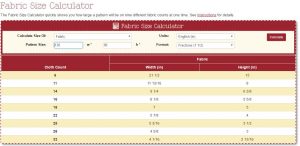 Many cross stitchers will stitch on nothing but Aida because it is easy to find and easy to work with. It comes in a lot of sizes and colors and you can find it in many shops. Aida can have a “chunky” look to it because of the way it is made. Here’s an example of 14 count Aida, and you can readily see where your needle should go.
Many cross stitchers will stitch on nothing but Aida because it is easy to find and easy to work with. It comes in a lot of sizes and colors and you can find it in many shops. Aida can have a “chunky” look to it because of the way it is made. Here’s an example of 14 count Aida, and you can readily see where your needle should go.

Evenweave, on the other hand is harder to figure out in the beginning. Here’s an example of a 25 count Lugana. The holes are not as obvious as this (and all evenweaves) are made up of one thread running vertically and one thread running horizontally. By way of comparison, Aida has clusters of 4 threads.
Evenweave comes in so many different styles and counts it can be very confusing. Linen is probably the best known but is the hardest to work with. It can have uneven slubs because it is a natural plant fiber. I know, uneven spots in evenweave sounds like an oxymoron but it is really not. Evenweave means the loom has been set for so many stitches per inch in both directions. My recommendations for a first project are Jubilee, Monaco, or Lugana. All have nice rounded threads, come in lots of pretty colors and counts, and are very easy to work on. If you are used to 14 count Aida, look for 28 count evenweave.
For your first project, I will suggest 25 count Lugana as it is a little bit larger. You are stitching over 2 threads, so you take the thread count and divide by 2 to get how many stitches per inch.But why torture yourself for something that is supposed to be relaxing? For one, fractional stitches are a breeze on evenweave. For two, your work looks so much more elegant on it. If you are stitching that is fully covered by stitches and doesn’t have a lot of fractionals, Aida is a great way to go. But, if you are on the curious side, give it a go.
To start cross stitching, locate your starting point on your chart. Everyone starts in a different place. Some always start in the upper corner, which is fine but it means you will have to count both vertically and horzontally to find the correct spot to start. I usually like my work to be centered so that I have enough excess for framing or mounting.  Find the spot closest to your starting point where the vertical thread is on top of the horizontal one. This is where your needle goes. Check this blowup of evenweave. I have a red dot just to the right of the hole where your needle will go for the first stitch. See it? Just remember, you want to ride on TOP of the bridge to enjoy the view.
Find the spot closest to your starting point where the vertical thread is on top of the horizontal one. This is where your needle goes. Check this blowup of evenweave. I have a red dot just to the right of the hole where your needle will go for the first stitch. See it? Just remember, you want to ride on TOP of the bridge to enjoy the view.
 Doing the magnets for the Finland Handcrafters Team gave me a chance to do a side by side. Here’s the same exact design done on 32 count Lugana (left) and also on 16 count Aida (right). Personally, I think the one on Lugana is just a bit more special. This is the one that will be going into the special promotion basket. (For more information, check my earlier post!!) These have not yet been blocked, sorry!!
Doing the magnets for the Finland Handcrafters Team gave me a chance to do a side by side. Here’s the same exact design done on 32 count Lugana (left) and also on 16 count Aida (right). Personally, I think the one on Lugana is just a bit more special. This is the one that will be going into the special promotion basket. (For more information, check my earlier post!!) These have not yet been blocked, sorry!!

And here are the finished magnets. The evenweave magnet is on the left.
See how much more delicate the butterfly looks when stitched on evenweave? It’s really all about using the materials at hand to make our creations come out the way we see them in our mind. There are just so many lovely lovely fabrics to choose from these days. Don’t limit yourself to just working with Aida!
If you are still lost, there are tons of videos out there that show you exactly where to start. Take an easy design, a piece of evenweave, grab a cup of coffee and spend some quiet time bonding with your fabric. I can guarantee that once you try it, you will be hooked and actually look forward to stitching on these exciting fabrics.
 I worked on something different yesterday, and I did promise a progress picture on the geese for the RCMP detachment in British Columbia. You can scroll down to the previous post for the reference picture, or simply click here.
I worked on something different yesterday, and I did promise a progress picture on the geese for the RCMP detachment in British Columbia. You can scroll down to the previous post for the reference picture, or simply click here. 





